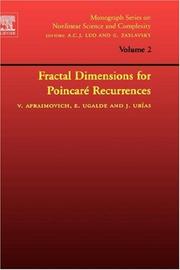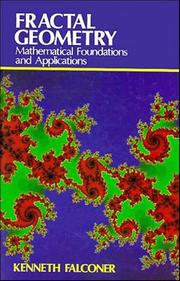| Listing 1 - 10 of 67 | << page >> |
Sort by
|
Book
ISBN: 9535150073 9535107291 Year: 2012 Publisher: IntechOpen
Abstract | Keywords | Export | Availability | Bookmark
 Loading...
Loading...Choose an application
- Reference Manager
- EndNote
- RefWorks (Direct export to RefWorks)
The fractal analysis is becoming a very useful tool to process obtained data from chaotic systems in geosciences. It can be used to resolve many ambiguities in this domain. This book contains eight chapters showing the recent applications of the fractal/mutifractal analysis in geosciences. Two chapters are devoted to applications of the fractal analysis in climatology, two of them to data of cosmic and solar geomagnetic data from observatories. Four chapters of the book contain some applications of the (multi-) fractal analysis in exploration geophysics. I believe that the current book is an important source for researchers and students from universities.
Fractal Analysis. --- Fractal geometric analysis --- Geometric analysis --- Fractal geometry

ISBN: 1280641851 9786610641857 0080462391 0444521895 9780444521897 9780080462394 9781280641855 6610641854 Year: 2006 Publisher: Amsterdam ; London : Elsevier Science,
Abstract | Keywords | Export | Availability | Bookmark
 Loading...
Loading...Choose an application
- Reference Manager
- EndNote
- RefWorks (Direct export to RefWorks)
This book is devoted to an important branch of the dynamical systems theory : the study of the fine (fractal) structure of Poincare recurrences -instants of time when the system almost repeats its initial state. The authors were able to write an entirely self-contained text including many insights and examples, as well as providing complete details of proofs. The only prerequisites are a basic knowledge of analysis and topology. Thus this book can serve as a graduate text or self-study guide for courses in applied mathematics or nonlinear dynamics (in the natural sciences). Moreover, the bo
Fractals. --- Poincaré series. --- Series, Poincaré --- Fractal geometry --- Fractal sets --- Geometry, Fractal --- Sets, Fractal --- Sets of fractional dimension --- Dimension theory (Topology)
Periodical
ISSN: 23081317 Year: 2014 Publisher: Zürich, Switzerland : European Mathematical Society Publishing House,
Abstract | Keywords | Export | Availability | Bookmark
 Loading...
Loading...Choose an application
- Reference Manager
- EndNote
- RefWorks (Direct export to RefWorks)
Fractals --- Fractals. --- Fractal geometry --- Fractal sets --- Geometry, Fractal --- Sets, Fractal --- Sets of fractional dimension --- Dimension theory (Topology)
Book
ISBN: 9811697159 9811697167 Year: 2022 Publisher: Gateway East, Singapore : Springer,
Abstract | Keywords | Export | Availability | Bookmark
 Loading...
Loading...Choose an application
- Reference Manager
- EndNote
- RefWorks (Direct export to RefWorks)
Fractals. --- Rock mechanics. --- Fractal geometry --- Fractal sets --- Geometry, Fractal --- Sets, Fractal --- Sets of fractional dimension --- Dimension theory (Topology) --- Geotechnical engineering --- Mechanics

ISBN: 0471922870 9780471922872 Year: 1990 Publisher: Chichester: Wiley,
Abstract | Keywords | Export | Availability | Bookmark
 Loading...
Loading...Choose an application
- Reference Manager
- EndNote
- RefWorks (Direct export to RefWorks)
Differential geometry. Global analysis --- Fractals --- Fractales --- Fractals. --- 517.542 --- #WPLT:dd.Prof.F.Symons --- Fractal geometry --- Fractal sets --- Geometry, Fractal --- Sets, Fractal --- Sets of fractional dimension --- Dimension theory (Topology) --- Mappings of special domains --- 517.542 Mappings of special domains
Book
ISBN: 3319333097 3319333100 Year: 2016 Publisher: Cham : Springer International Publishing : Imprint: Springer,
Abstract | Keywords | Export | Availability | Bookmark
 Loading...
Loading...Choose an application
- Reference Manager
- EndNote
- RefWorks (Direct export to RefWorks)
This book focuses on turbulent flows generated and/or influenced by multiscale/fractal structures. It consists of six chapters which demonstrate, each one in its own way, how such structures and objects can be used to design bespoke turbulence for particular applications and also how they can be used for fundamental studies of turbulent flows.
Engineering. --- Fluid mechanics. --- Engineering Fluid Dynamics. --- Turbulence --- Fractals. --- Mathematical models. --- Fractal geometry --- Fractal sets --- Geometry, Fractal --- Sets, Fractal --- Sets of fractional dimension --- Dimension theory (Topology) --- Hydraulic engineering. --- Engineering, Hydraulic --- Engineering --- Fluid mechanics --- Hydraulics --- Shore protection --- Hydromechanics --- Continuum mechanics
Periodical
ISSN: 25043110 Year: 2017 Publisher: Basel : MDPI : 2017-
Abstract | Keywords | Export | Availability | Bookmark
 Loading...
Loading...Choose an application
- Reference Manager
- EndNote
- RefWorks (Direct export to RefWorks)
functional analysis --- quantum algebra --- nuclear physics --- thermodynamic --- algorithms --- geometry --- Mathematical analysis --- Thermodynamics --- Fractals --- Fractales --- Fractals. --- Fractal geometry --- Fractal sets --- Geometry, Fractal --- Sets, Fractal --- Sets of fractional dimension --- Dimension theory (Topology)
Book
ISBN: 1789854342 1789854334 1839621125 Year: 2019 Publisher: IntechOpen
Abstract | Keywords | Export | Availability | Bookmark
 Loading...
Loading...Choose an application
- Reference Manager
- EndNote
- RefWorks (Direct export to RefWorks)
The aim of this book is to show some applications of fractal analysis in the fields of sciences. The first chapter introduces the readers to the book, while the second chapter shows the methods and challenges of fractal analysis of time-series data sets. The third chapter demonstrates fractal geometry as an attractive choice for miniaturized planar microwave filter design. The fourth chapter presents fractal antennas for wearable applications. The objective of the fifth chapter is to show some Parrondian games in discrete dynamic systems, while the last chapter reveals fractal structures of carbon nanotube system arrays.
Fractal analysis. --- Fractals. --- Fractal geometry --- Fractal sets --- Geometry, Fractal --- Sets, Fractal --- Sets of fractional dimension --- Dimension theory (Topology) --- Fractal geometric analysis --- Geometric analysis --- Physical Sciences --- Engineering and Technology --- Dynamical Systems Theory --- Mathematics --- Applied Mathematics
Book
Abstract | Keywords | Export | Availability | Bookmark
 Loading...
Loading...Choose an application
- Reference Manager
- EndNote
- RefWorks (Direct export to RefWorks)
Until recently, a majority of the applications of X-ray computed tomography (CT) scanning in plant sciences remained descriptive; some included a quantification of the plant materials when the root-soil isolation or branch-leaf separation was satisfactory; and a few involved the modeling of plant biology processes or the assessment of treatment or disease effects on plant biomass and structures during growth. In the last decade, repeated CT scanning of the same plants was reported in an increasing number of studies in which moderate doses of X-rays had been used. Besides the general objectives of Frontiers in Plant Science research topics, “Branching and Rooting Out with a CT Scanner” was proposed to meet specific objectives: (i) providing a non-technical update on knowledge about the application of CT scanning technology to plants, starting with the type of CT scanning data collected (CT images vs. CT numbers) and their processing in the graphical and numerical approaches; (ii) drawing the limits of the CT scanning approach, which because it is based on material density can distinguish materials with contrasting or moderately overlapping densities (e.g., branches vs. leaves, roots vs. non-organic soils) but not the others (e.g., roots vs. organic soils); (iii) explaining with a sufficient level of detail the main procedures used for graphical, quantitative and statistical analyses of plant CT scanning data, including fractal complexity measures and statistics appropriate for repeated plant CT scanning, in experiments where the research hypotheses are about biological processes such as light interception by canopies, root disease development and plant growth under stress conditions; (iv) comparing plant CT scanning with an alternative technology that applies to plants, such as the phenomics platforms which target leaf canopies; and (v) providing current and potential users of plant CT scanning with up-to-date information and exhaustive documentation, including clear perspectives and well-defined goals for the future, for them to be even more efficient or most efficient from start in their research work.
Book
ISBN: 0201587017 9780201587012 Year: 1993 Publisher: Reading (Mass.) Addison-Wesley
Abstract | Keywords | Export | Availability | Bookmark
 Loading...
Loading...Choose an application
- Reference Manager
- EndNote
- RefWorks (Direct export to RefWorks)
Differential geometry. Global analysis --- Fractals --- Fractales --- Fractals. --- 517.987 --- #WBIB:dd.Lic.L.De Busschere --- Measures. Representations of Boolean algebras. Metric theory of dynamic systems --- 517.987 Measures. Representations of Boolean algebras. Metric theory of dynamic systems --- Fractal geometry --- Fractal sets --- Geometry, Fractal --- Sets, Fractal --- Sets of fractional dimension --- Dimension theory (Topology)
| Listing 1 - 10 of 67 | << page >> |
Sort by
|

 Search
Search Feedback
Feedback About
About Help
Help News
News